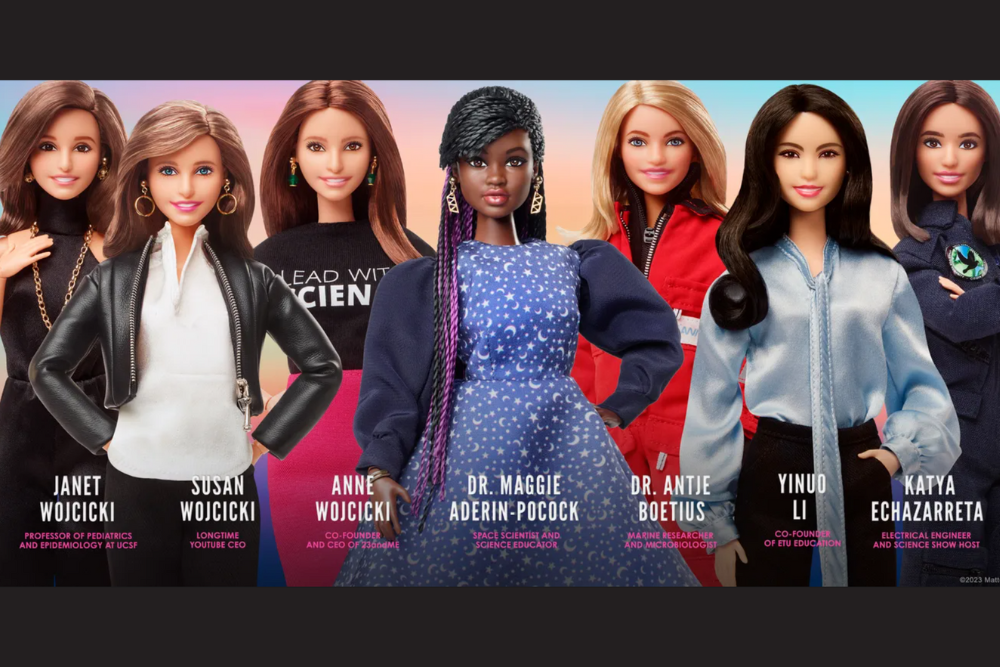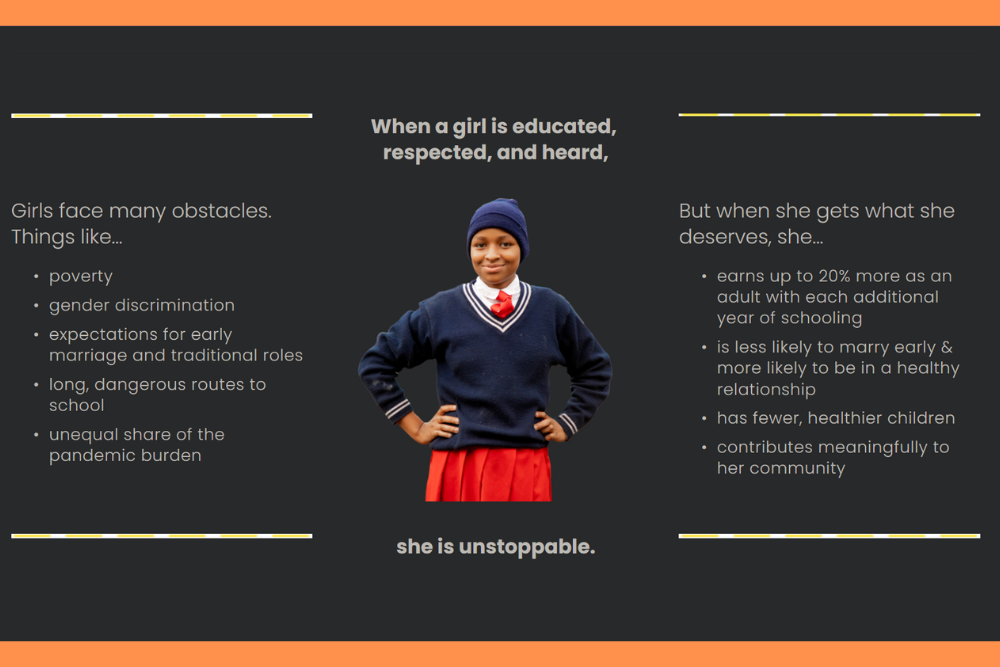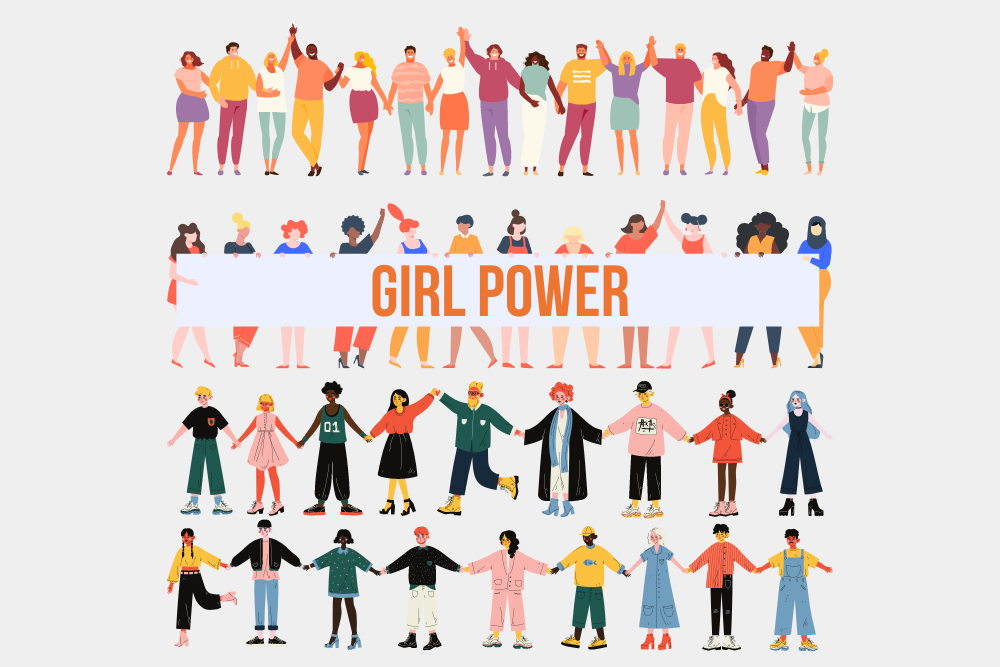Girl power is real, creates tangible results, & vital to healing the world. Check out these young heroines who are writing the next chapter of Women’s History!
“I hear a lot of people saying, when talking about girls’ empowerment and women as well, you’ll often hear people saying, ‘You’re helping them find their voices’, I fundamentally disagree with that. Women don’t need to find their voice. They need to feel empowered to use it and people need to be encouraged to listen.”
–Meghan Markle
“We teach girls to shrink themselves, to make themselves smaller. We say to girls, you can have ambition, but not too much. You should aim to be successful, but not too successful. Otherwise, you would threaten the man.”
–Chimamanda Ngozi Adichie
In this article:
- Don’t Call Me Princess(?)
- Blossoming & Barbies
- Girls on our Watch List of Future Leaders
- Organizations for Girls
- Where We Come In
Don’t Call Me Princess(?)
Rockstar. Sunflower. Brainiac. Tenacious G(irl). Science Queen. Valkyrie. Shield-maiden. Little Riveter. Rainbow Maker. Insightful leader.
What came to mind for you when you heard these “princess” alternatives? I feel empowered. Purpose. Drive. Capacity. Capability. Resilience. Inner trust. Like there is something inside of me that is seen that sometimes I even forget is there.
While nothing is inherently wrong with calling a girl a princess, there are some downsides to it being her only nickname exposure. However, as with most things in life, too much of a good thing can be not so good.
Example: Exercise is great, but not if you push yourself too hard and overtrain. When you do, you fatigue your body and cannot recover properly, become injury-prone, you lose interest in the activity, and more.
And there have been some recent uncoverings that a healthy dose of Disney “princess culture” actually has some positive influences on girls! This part really surprised me, as being a tomboy when I was younger, I enjoyed Disney flicks but never really had a desire to be a princess. But apparently, these girls grow up to believe that boys ought not to repress their human emotions, score higher on self-esteem, and outgrew acting like divas.
As brand representatives, what we put out there catches eyes, even the littlest ones. Especially those.
BACK TO TOP
Blossoming & Barbies
In an age where TVs, screens, and media are around us at almost any given hour, there is a lot that is absorbed both with and without our knowledge. There are so many mixed messages trying to grab our attention, and for those who are still just getting familiar with the rules and weirdnesses of the world (aka kids), the messages we send out are our responsibility.
The undertones of the messages corporations send aren’t just an advertisement–they’re a communication of cultural ideals and opinions. As the world gets more and more connected each day, the influence we have on the world and that it has on us is extensive. The only way to a bright future is a planned and intentional one. It’s unavoidable; change will happen with or without our input. It’s an exciting prospect that those currently in the spotlight have an opportunity to lead the charge.
As businesses, it’s our privilege and prerogative to mature to the next stage of growth and be socially responsible, even when it’s an uphill battle. If you aren’t climbing, you’re denying yourself actual success by settling in relative success.
I’ve found a couple of really neat things that some big brands have done that make my inner preteen burst with girl power. ?⚡
Always, #LikeAGirl
Not super new but totally spot-on advertising, Always is doing their part to redefine stereotypes and give girl’s the moral support in reclaiming the tired, inaccurate and lame insult of doing things “like a girl.” They’re paving the way for girls to take their power back and own the everloving daylight out of it, #LikeAGirl. This message that Always sends emboldens not just the littlest heroines, but also grown ladies alike to believe in their inner strength and ability to apply themselves.
Barbie, Dream Gap Project
In 2018, famous toy making Barbie started the “Dream Gap Project,” a campaign dedicated to closing the gender self-belief gap that studies have shown that an unfortunate amount of girls start believing they aren’t as capable as boys as young as five–especially black girls.
“[Girls] stop believing their gender can be anything. This issue is called the Dream Gap, and to help close it, Barbie launched […] an ongoing global initiative that gives girls the resources and support they need to continue believing in themselves.”
–Barbie, “Barbie Dream Gap”
Barbie is redefining what it means for their dolls to include role models beyond the external, specific (monotonous?) beauty scene into a colorful world of influential examples of inspiring diversity in the name of “encouraging purposeful play.” ? One of their most recent releases is taking the science world by storm: seven STEM (science, technology, engineering and mathematics) women are honored this year, and the reviewers are raving.
Girls seeing an array of amazing women to play purposefully with has lit up the internet: Hispanic space tourist and engineer Katya Echazarreta, Black space scientist and educator Maggie Aderin-Pocock, Ph.D., and Asian molecular biologist Yinuo Li, Ph. D, are among some of the celebrated. Women from around the world who are doing great things, coming soon to a toy box near your kids!

BACK TO TOP
Girls on our Watch List of Future Leaders
Speaking of these cool “girl power” focused toys and products, I’m excited to dive into the really good stuff! I could spend all day reading about all of these amazing girls from around the world. Here is our short list of who we think we’ll be hearing about for years to come:
Greta Thunberg
This name is likely a bit familiar to you if you have ever heard of the topic of global warming or climate change. When 8, Greta Thunberg started to learn about climate change. Well-known for having ASD, or autism, her special interest became saving the earth. By the time she was 15, she was striking against going to school to make world leaders take notice and challenge their inaction on problematic environmental policies. She faced a lack of active support from her family and teachers, saying that as people, they agree with her, but that she ought to be in school.
Thunberg stayed true to herself, however. And it sparked an international movement where other youth activists followed in her footsteps in what has been called “the Greta effect.”
Jordan Reeves
At 15 years old, Jordan Reeves has gained national attention for her work in designing prosthetics for children and advocating for more inclusive design in the tech industry. She has asked some big questions at 10 years of age, like since American Girl dolls can have hearing aids, braces, wheel chairs, and insulin kits, why not adjustable limb options? Born Just Right with a limb difference where her left arm ends before the elbow, Reeves published her book at just 13. Mattel, who design Barbie dolls, consulted Reeves on the company’s first ever doll with a limb difference.
Gitanjali Rao
It takes a lifetime achievement to land on the cover of TIME, and for Gitanjali Rao, that only took her 15 years to accomplish. 2020 marked the magazine’s first-ever Kid of the Year award, and Rao was the flagship recipient for her work in developing technology to address issues such as cyberbullying, water contamination, and opioid addiction. An inventor, thought leader, social activist and innovator, this girl is already doing amazing things!
Zuriel Oduwole
While visiting Ghana as a child, Zuriel Oduwole was so moved by the lack of opportunities for the resident children, including school, that she jumped into action. The youngest person ever to be profiled by Forbes at 10 in 2013, Oduwole is a young filmmaker and activist who has interviewed several African presidents and advocated for girls’ education. A passionate speaker, she has reached out and spoken for over 50,000 youths in 19 countries about the power of a good education, and at 2017’s United Nations Climate Change Conference about the distinct dependency between education and climate change.
BACK TO TOP
Organizations for Girls
There are also some really kick-butt programs and initiatives out there for girls who are looking to network, have access to resources, and follow dreams. These are just a few that we find particularly excellent:
STEM:
Girls Who Code is any girl’s dream non-profit organization! Their mission is to close the gender gap in technology and computing by inspiring and educating young girls to pursue careers in computer science and engineers. Girls Who Code was founded in 2012 by Reshma Saujani, a lawyer and activist, who noticed a significant gender gap in tech spaces starting at super young ages. The reach is huge in the United States with over 300,000 girls participating. Part of this has been supported in partnership with companies like Google, IBM, and Microsoft.
Girls Who Code offers various programs, including summer camps, after-school programs, and clubs, to girls in grades 3 to 12 teach girls coding skills, encourage them to pursue careers in technology, and provide them with a supportive community of peers and mentors. There are even various course approaches for different learning styles.
(Discover more similar resources to support girls at EdVentures!)
Society & Culture:
Girls Not Brides is a world-wide partnership of over 1,500 non-governmental organizations working collectively to end the practice of child marriage to give girls the chance to live out their potential. The fact that this practice affects millions of girls on our planet is problematic in even more ways because of the strong correlations with poverty, a lack of education, poor health outcomes, and experiencing violence. Ending child marriage is an multidimensional undertaking, and through Girls Not Brides, support comes from more than 100 countries in promoting girls’ rights around the globe.
She’s the First crosses over into the mentorship category below. This global organization drives change to support gender equality through community-based education and programming. Girls from Latin America, Eastern Africa, Western Africa, and Southeast Asia who will be the first girl in their family to graduate high school are led and trained by mentors to learn leadership skills and education to give them a leg up on overcoming their circumstantial barriers and rise above.

Mentorship:
Strong Women, Strong Girls (grades 3-5), founded by strong woman Lindsay Hyde, is a nonprofit organization championing the next generation of female leaders through our innovative, multi-generational mentoring programs. Hyde started the program while at Harvard University as a way to connect college women with girls in their surrounding community. That’s pretty cool, honestly. I wish my university had taken after this initiative!
With focuses on four key areas: leadership, communication, positive self-image, and community engagement, these programs encourage girls to be game changers. They learn how to set goals for themselves, develop their own leadership style, and become advocates for themselves and others in their communities.
Girls Write Now’s vision statement snaps:
“We are a powerhouse of voices that have been ignored or silenced for too long.
We are a pipeline of talent into schools and industries in need of different perspectives.
As a community, we follow our hearts and—through bold, authentic storytelling—inspire people to open theirs.”
Based in NYC since 1998 by Maya Nussbaum, Girls Write Now is a nonprofit organization based in New York City that aims to empower young women through writing and one-on-one mentorship. Nussbaum saw a gap that needed filling for safe spaces where girls of grades 9-12 and beyond could express themselves. Through writing and connection with mentors who could support and guide them, the girls work to develop their writing skills, explore the depths of their imagination, gain confidence in themselves and their abilities, and collaborate on college prep and professional development.
Poverty:
Girl Effect is a powerful force for bettering the lives of girls in developing countries through a variety of media platforms and technology, engaging and informative education, and health and economic empowerment. Since its founding in 2008, the organization’s goal continues to be creating a positive social and economic impact for girls and their communities. One of their finest initiatives is the TEGA program (Technology Enabled Girl Ambassadors), which trains girls to collect data using mobile technology to open doors to the future in research and advocacy for themselves and those within their own communities for human rights and justices.
Girl Effect also partners with a variety of organizations and corporations to provide resources and support for girls and their families. For example, they’ve partnered with Nike to provide sports programs for girls where they’ve never had any before, and with Unilever to promote hygiene and health education.
BACK TO TOP
Where We Come In
While this is just a small list of global efforts, there are many more local institutions that are working with the youth of their local communities and deserve recognition and support. A monetary pledge can go a long way to help out such organizations. It’s equally important, if not more important, for those of us who can to gift time and physical presence to take tangible part in making it possible for young girls craft an intentional life to follow dreams, make waves, and lead our world into a healthy future. Last, and certainly not least, is continuing to educate ourselves and our teams and never stop learning!
Let’s keep fighting the good fight like a boss. Like a unified community. Like a girl.
Further Reading:
- Women’s History Month: 11 Nonprofits That Are Advocating For Female Empowerment
- Want to raise a strong, confident girl? Add these 10 toys to your holiday gift list
- 16 Girls Who Changed The World
BACK TO TOP



